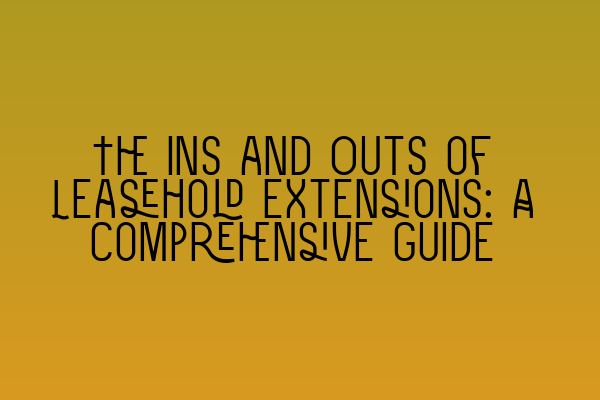The Ins and Outs of Leasehold Extensions: A Comprehensive Guide
Are you a leaseholder looking to extend your lease? Or maybe you’re a property owner considering selling a leasehold property? Understanding the intricacies of leasehold extensions is crucial for both parties involved. This comprehensive guide will walk you through everything you need to know about leasehold extensions, from the basics to the finer details. So, let’s dive in!
What is a Leasehold Extension?
Before we delve deeper into the topic, it’s important to understand what exactly a leasehold extension entails. In simple terms, a leasehold extension allows the leaseholder to extend their lease beyond the original term agreed upon in the lease agreement. This is particularly relevant for residential leasehold properties, such as flats or apartments.
Why Extend a Leasehold?
There are several reasons why leaseholders opt to extend their lease. Firstly, a longer lease provides greater security and peace of mind to homeowners. It ensures that they can continue to live in their property without the risk of eviction once the lease term expires. Additionally, a longer lease is often more attractive to potential buyers, making it easier to sell the property if desired.
Counting Down the Years: The 80-Year Threshold
Leasehold extensions become a particularly pressing matter as the lease term decreases, especially when it drops below 80 years. This is because once the lease falls below 80 years, the cost of extending the lease significantly increases. It is worth noting that leaseholders can only extend their lease once they have owned the property for a minimum of two years, as per the Leasehold Reform, Housing, and Urban Development Act 1993.
The Leasehold Reform Process
Now that we’ve established the importance of leasehold extensions, let’s explore the step-by-step process involved in extending a lease. The process typically involves the following key stages:
1. Eligibility Check: Determine whether you meet the criteria for a leasehold extension, including the ownership duration and the type of property you own.
2. Valuation: Seek a professional valuation from a qualified surveyor to assess the value of the leasehold extension. This valuation will form the basis for negotiations with the freeholder.
3. Section 42 Notice: Serve the freeholder with a Section 42 Notice, which indicates your intention to extend the lease and provides the terms you propose. It is vital to seek legal advice at this stage to ensure the notice complies with all legal requirements.
4. Freeholder’s Response: The freeholder has a statutory period within which to respond to the Section 42 Notice. They may either accept the terms proposed or propose alternative terms, such as the premium payable for the leasehold extension.
5. Negotiations: If the freeholder responds with alternative terms, negotiations may ensue to reach an agreeable outcome for both parties involved. This can be a complex process, and it is crucial to have a solicitor who specializes in property law on your side.
6. Deed of Variation: Once the terms are agreed upon, a Deed of Variation is drafted and signed by both parties. This legal document details the agreed-upon changes to the lease and is registered with the Land Registry.
7. Paying the Premium: The leaseholder is then responsible for paying the premium for the leasehold extension, as agreed upon in the negotiations.
8. Post-Extension Formalities: Finally, after the leasehold extension is completed, it is essential to update official records and notify relevant parties, such as mortgage lenders and insurance companies, of the changes.
Factors Influencing the Cost of a Leasehold Extension
The cost of a leasehold extension can vary depending on several factors. Some of the key determinants include:
1. Remaining Lease Term: The shorter the remaining term, the higher the premium is likely to be.
2. Property Value: The value of the property also affects the cost of the leasehold extension. Generally, the more valuable the property, the higher the premium.
3. Ground Rent: The annual ground rent payable can impact the cost of the leasehold extension. Higher ground rents may result in higher premiums.
4. Clause 80 Notice: In some cases, leaseholders may be required to serve a Clause 80 Notice, which provides compensation to the freeholder for loss of development potential.
Seeking Professional Advice
Given the complexity and legalities involved in leasehold extensions, it is highly recommended to seek professional advice from a solicitor specializing in property law. They will ensure that all necessary procedures are followed correctly, provide guidance throughout the process, and protect your interests as a leaseholder.
At SQE Property Law & Land Law, we are experts in leasehold extensions and can assist you every step of the way. Contact us today for expert advice and representation!
Conclusion
Leasehold extensions are a crucial aspect of property ownership, offering security and enhanced marketability for leaseholders. By understanding the process and seeking professional advice, leaseholders can navigate the intricacies of extending their lease with confidence. At SQE Property Law & Land Law, our team of solicitors is dedicated to providing expert guidance and support throughout the leasehold extension process. Contact us today to ensure a smooth and successful lease extension experience.
Related Articles:
– SQE 1 Practice Exam Questions
– SQE 1 Practice Mocks FLK1 FLK2
– SQE 2 Preparation Courses
– SQE 1 Preparation Courses
– SRA SQE Exam Dates
